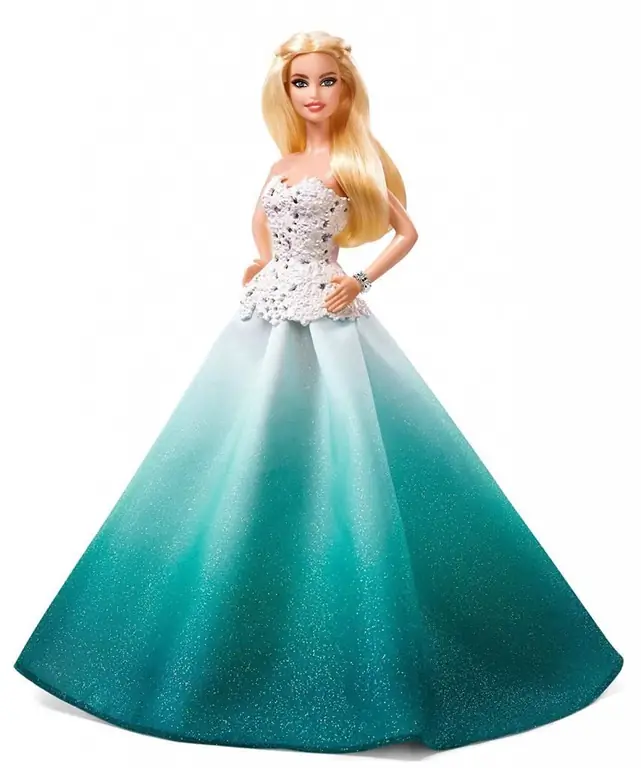2025 Author: Priscilla Miln | [email protected]. Last modified: 2025-01-22 17:55:18
In Russia, the traditional matryoshka doll appeared relatively recently: only in the 90s of the XIX century. Nevertheless, already during the World Exhibition in Paris in 1900, the matryoshka managed to win a gold medal, confirming the status of a national symbol.
In the beginning it was…
Despite the fact that all over the world the matryoshka is considered an invariable symbol of Russian culture, few people know that Daruma, the Japanese “matryoshka”, which was the personification of Bodhidharma, served as the prototype of this famous folding doll. However, the history of its appearance has much more ancient roots.
The first folding dolls appeared in ancient China during the Song Empire, around 1000 AD. e. Outwardly, they did not look like dolls at all. These were small boxes, beautifully decorated and multifunctional. Much later, in the 18th century, the principle of their arrangement began to be used to make sets of folding dolls: each larger doll contains a smaller doll. And so the first “matryoshka dolls” appeared.

In the Chinese version, inside thesmall doll contained only one grain of rice - a symbol of divine spiritual food.
What about Japan?
According to the legends, a long time ago a Buddhist monk from India settled in China and founded the Shaolin Monastery there, where he meditated day and night for 9 years. The name of the sage was Bodhidharma. In Japanese, this name is known as Daruma. Like St. Anthony, who was subjected to numerous temptations during his stay in the desert, Daruma had to overcome all sorts of trials that now and then fell upon him. One day the sage realized that instead of meditating he was in a dream. Then Daruma did a desperate act: cutting off his eyelids, he threw them to the ground and continued his meditation. Subsequently, due to a long sitting, Daruma lost control of his own arms and legs, so a wooden doll with his image, which appeared in Japan, is usually depicted as legless and armless.

Hundreds and thousands of Japanese annually perform a special New Year's ritual associated with their belief in the miraculous power of Daruma. The Japanese nesting doll itself has a rounded shape, in fact, being not so much a “nesting doll” in the traditional sense, but a tumbler doll. She has large round eyes without pupils, which is necessary for performing the ritual. A doll is bought in a temple and a wish is made at home. Then one eye is painted, that is, Daruma's eye is opened. In this form, the nesting doll will stand in the house for a whole year, and if the wish is fulfilled during this time, then the second eye is painted on it. This is thanks to Daruma. OtherwiseIn this case, the Japanese matryoshka is taken back to the temple, burned, and a new one is bought.

Seven human bodies
There is another version of the origin of the Japanese matryoshka. The toy, according to her, was connected with Eastern philosophy by a Russian monk who fled to Japan. The image of Fukuruma (or Fukurokuju) became the prototype of this nesting doll.

In the Japanese tradition, there are seven gods of happiness - the so-called shichifukujin, each of which controls only one of the seven human bodies. Among them is the one that is responsible for wisdom, high intellectual abilities and we alth - Fukuruma. The Japanese nesting doll with his image has its own unique features. This is, first of all, a high elongated forehead, on which deep wrinkles are visible, and a staff that Fukuruma holds in his hands.

But how did the nesting doll itself appear? No one can say for sure. It is believed that once an unknown Japanese master created seven Shichifukujin dolls and placed one inside the other. The largest and most important among them was Fukuruma. His whole "divine" family was hiding in it.
Road to Russia
In continuation of this version of the appearance of the Russian nesting doll, it is worth noting that many people seriously believe that it was this Japanese nesting doll, with the image of Fukuruma, that was brought to Russia in 1890. And they brought it not just anywhere, but to the Abramtsev estate, where the printer Anatoly Mamontov, brother of the famous Russian philanthropist Savva, livedMamontov. He owned the Children's Education workshop, where modernist artist Sergei Malyutin and turner Vasily Zvezdochkin worked.
When the artist saw a Japanese doll and was inspired by its unusual device, an interesting idea arose in his head. He soon outlined it to Zvezdochkin, from whom he ordered the manufacture of the first Russian nesting doll in Russia. Malyutin painted the dolls with his own hands. At first, they were modest girls in simple dresses, painted with gouache. However, later the painting became more complicated - matryoshka dolls appeared with complex floral ornaments and fairy tales. The number of nesting dolls from one set also increased. But the very first matryoshka is still not lost. It is stored in the toy museum in Sergiev Posad.

Let's go back to Japan
We have already considered three versions of the origin of the matryoshka, but there is also a fourth one. There is another Japanese nesting doll - kokeshi (or kokeshi). Its place of origin is Tohoku, the outskirts of the Japanese island of Honshu. As for the date of birth… Presumably, this is the XVII-XVIII centuries, but some experts say that the doll was born more than 1000 years ago.
Kokeshi is a beautifully painted girl. It is made of wood, and it consists of two separate parts: a small cylindrical body and a head (see photo of a Japanese nesting doll below). It happens that kokeshi are made from a single block of wood, but this is very rare. Note that this Japanese doll also has no arms or legs.

Kokeshi is made from a wide variety of woods, from maple and birch to sophisticated cherrywood. The doll is usually painted in red, black and yellow and decorated with plant motifs so characteristic of Japanese culture.
Interestingly, traditional kokeshi have at least 11 types of shape. The most popular is "naruko kokeshi". Her head can turn, and the doll itself makes a sound very similar to a quiet cry. Hence her second name, “weeping kokeshi.”
Today there is a wide variety of copyright kokeshi. Shapes, proportions of the body, their colors can be absolutely anything. Everything is at the discretion of the master. Pictures of Japanese nesting dolls with the author's design are presented below.

In general, kokeshi are an extremely popular toy in Japan today. They symbolize the cheerfulness, steadfastness of the way of Japanese culture, the continuity of the traditions of their ancestors. They have significant cultural value. Perhaps, according to these characteristics, Japanese nesting dolls are very similar to their Russian "sisters".
These are the assumptions about the origin of Russian matryoshka. As it turned out, it is not so traditional for the culture of Russia, as many used to think. One thing is certain: the prototype of collapsible dolls appeared in ancient times thanks to the efforts and imagination of Japanese masters. What came of it? See for yourself.
Modern dolls
Today, sets of collapsible dolls are very popular all over the world. Apart fromtraditional motifs, more and more often masters use their extraordinary and sometimes very bold ideas for painting nesting dolls. This is how nesting dolls appeared, depicting political leaders, musical idols, and animals. In fact, they show everything that the master's fantasy is capable of. The variety is so great that traditional motifs have almost completely faded into the background. Perhaps this is the secret of her popularity? Among the huge selection, everyone can find something to their liking.

For animal lovers
There are nesting dolls depicting birds, bears, cats and dogs - all this still reminds of ancient Russian traditions that have been preserved from time immemorial. How can these nesting dolls not touch and charge with positive?
Matryoshka-presidents and dolls for fans
Another original version of the nesting dolls painting is images of presidents and civil servants of various countries who are still politically active or have already left their mark on the history of mankind.
The theme of matryoshka painting that is relevant for this year is FIFA 2018. Having retained the original Russian appearance of the blue-eyed beauty, the matryoshka apron was decorated with the symbols of the main football competition.
Recommended:
Barbie doll sizes and step-by-step instructions for sewing a simple doll dress

You can't argue with the popularity of the Barbie doll. Almost every girl dreams of such a toy. Modern stores offer a wide variety of both the dolls themselves and the clothes for them. However, there are situations in which the young owner of Barbie is unable to try on her new outfit, because it does not fit. Mom can save the situation by sewing a simple dress for the doll. But first you need to know how the size of the Barbie doll is determined
Tumbler doll: photo, description. How to make a tumbler doll?

Grandparents of today's hyperactive toddlers, who are merrily and surprised trying to knock over their favorite toy, remember very well the Roly-Vstanka of their childhood. The roly-poly doll was one of the first entertainments of several generations
Name for a girl with a middle name Denisovna. Characteristics of suitable names and their influence on fate

Choosing a name for a girl from the fatherland Denisovna is not difficult. Many beautiful, sonorous names suitable for this patronymic have a positive effect on the fate of the future woman. In this article, you will get acquainted with the best and learn about the origin and character of their owners
What is the name of the cat? Selection of a name for a cat by color, character and horoscope

What is the name of the cat? How to choose the nickname that will match the appearance and character of the animal when it grows up? We have found answers to these and other important questions and we hasten to share them with the reader as soon as possible
When Vadim's name day is celebrated, the meaning of the name and its characteristics

Vadim's birthday is celebrated on April 22. This day in Orthodox Christianity is dedicated to the Hieromartyr Vadim of Persia, who was martyred for the Christian faith

